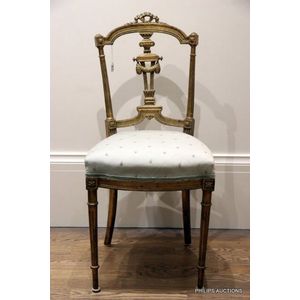Louis XVI Giltwood Occasional Table
An antique giltwood occasional table in the Louis XVI manner, 19th century, the delicately framed chair with an arching cresting rail with ribbon detail, a decorative pillar form splat with swags, side frames with bead work and paterae, a shaped stuffover seat and raised on slender reeded legs. provenance: Lesley Bragge Antiques, West Sussex 1990 for £155, height 86 cm, width 41 cm, depth 40 cm
You must be a subscriber, and be logged in to view price and dealer details.
Subscribe Now to view actual auction price for this item
When you subscribe, you have the option of setting the currency in which to display prices to $Au, $US, $NZ or Stg.
This item has been sold, and the description, image and price are for reference purposes only.
- Patera - A small decorative device, used as ornament in Neo-classical style furniture. Patera (or paterae) are usually round or oval, in the form of stylized rosettes. In the best pieces they are carved directly into the timber, otherwise they applied to the surface. Sometimes painted or inlaid motifs in the style are referred to as patera. Also known as a boss or a rosette.
- Cresting - The decorative carving at the top of a piece of furniture, such as a sideboard back, a mirror, or a chair back.
- Giltwood - Giltwood is used to describe a gold finish on furniture and other decorative wooden items, whereby a thin sheet of gold metal, called gold leaf, is applied to the surface for decorative purposes.
Unlike gilding, where the gold leaf is applied over a coating of gesso, with giltwood the gold leaf is applied direct to the surface, or over a coat of linseed oil gold leaf adhesive.
Most gold-finished mirrors will be gilded, whereas furniture with gold highlights will have the gold applied through the giltwood method. - Rail - A term used by cabinet makers for the horizontal sections of the frame of an item such as a chair or settee which have a front rail, a back rail and two side rails, and also on a door or carcase, where the rails are joined to the vertical framings.
- Provenance - A term used to describe the provable history of an antique or work of art, and thus an additional aid to verifying its authenticity. Provenance can have an inflating effect on the price of an item, particularly if the provenance relates to the early settlement of Australia, a famous person, or royalty. Less significant are previous sales of the item through an auction house or dealer.
- Reeding - A series of parallel, raised convex mouldings or bands, in section resembling a series of the letter 'm'. The opposite form of fluting, with which it is sometimes combined. Reeding is commonly found on chair legs, either turned or straight, on the arms and backs of chairs and couches and around table edges in the Neoclassical or Classical Revival manner. Reeding was also used as a form of decoration during the Edwardian period, but it is usually much shallower and evidently machine made.
- Floral Swag / Garland / Festoon - Floral swags are a decorative motif often used in the ornamentation of various objects, such as silverware, glassware, and furniture. The term "swag" refers to a garland or wreath of flowers, foliage, or other decorative elements, which is usually arranged in a loop or curve.
Floral swags can be found in a variety of decorative styles, from ornate Baroque and Rococo designs to more naturalistic Art Nouveau and Art Deco styles. They are often used to add a touch of elegance, refinement, or whimsy to an object, and can be seen on a range of items from chandeliers and candlesticks to picture frames and tea sets.
In the decoration of silver objects, floral swags are often used to accentuate the curves and lines of the piece, and to add visual interest to the surface. Similarly, on glass objects, floral swags may be used to frame or highlight a particular area of the object, or to add a touch of color and delicacy.
On furniture, floral swags can be found on a variety of pieces, from cabinets and armoires to chairs and sofas. They are often used to enhance the lines and curves of the furniture, and can be used to create a sense of movement and flow in the design.
Overall, floral swags are a versatile decorative element that can be adapted to a range of styles and applications, and have been used in the decoration of various objects throughout history.
This item has been included into following indexes:
